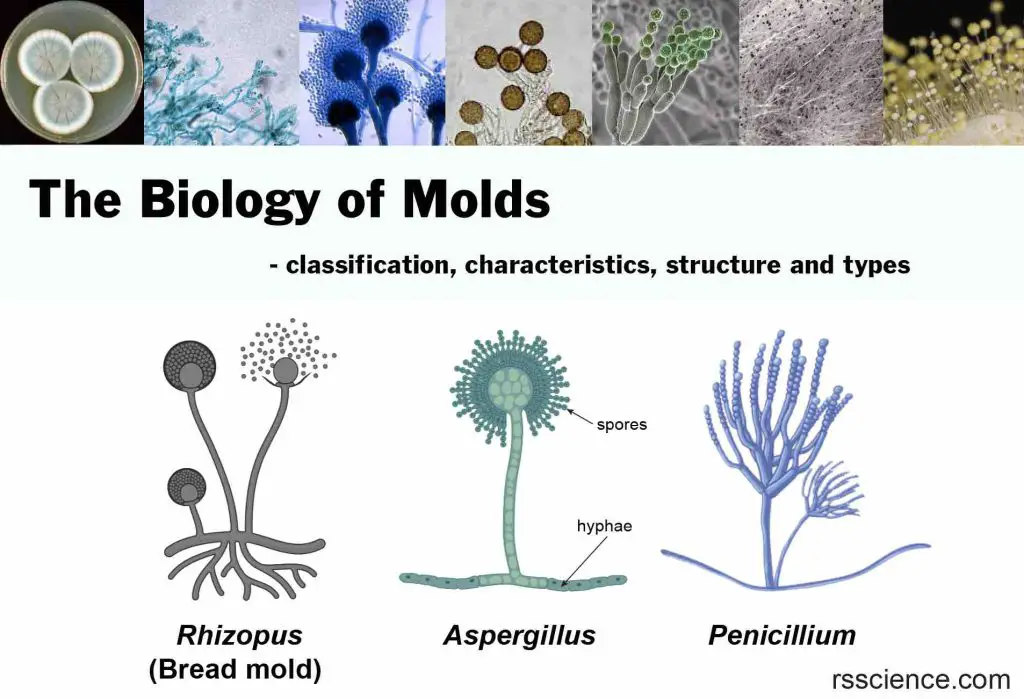Mold is a fungus that needs nutrients and water to grow. Mold can be found indoors and outdoors all over the world. Most are non-toxic, but they certainly aren’t good to eat!
In this article, we will explore the basics of molds, including what they are and how they grow. We will examine their cellular structure and classify them based on their unique characteristics. Additionally, we will discuss the Good and Bad of mold and provide examples of common types found in households. Let’s begin our exploration.
This article covers
What are Molds (or Moulds)? – A quick overview
Molds belong to the Kingdom of Fungus
A mold (US) or mould (UK) is usually referred to as a type of fungi (singular: fungus). Molds grow in multicellular fiber-liked structures called hyphae and reproduce by spreading spores. Unlike mushrooms that develop caps, gills, and stalks above the ground, molds do not grow into large fruit bodies. Molds are also distinct from yeasts which are single-celled fungi.
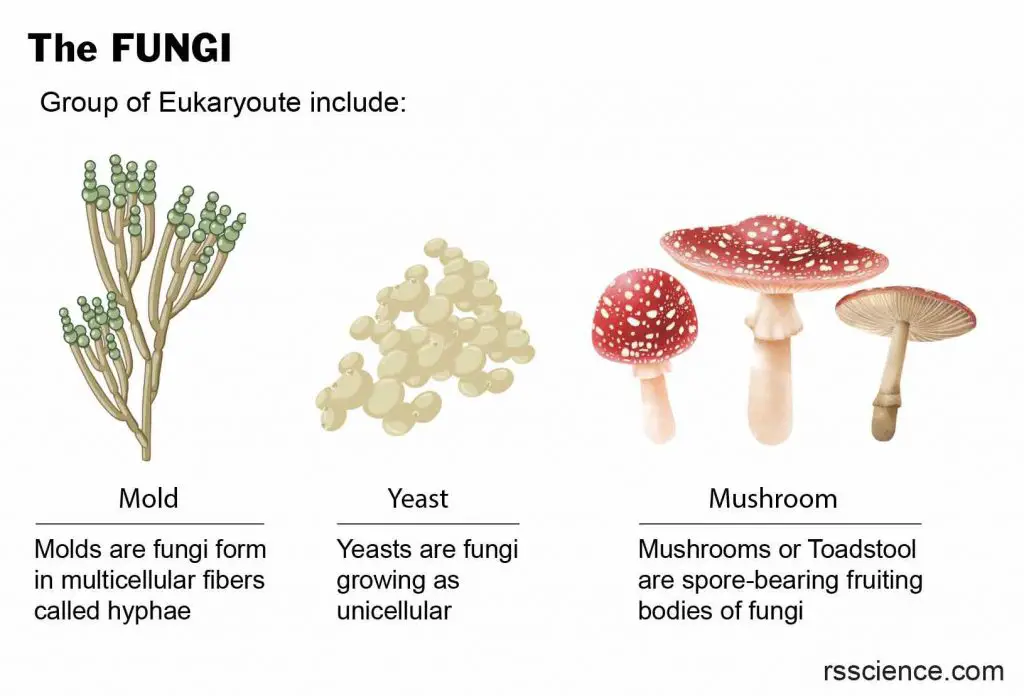
[In this image] Three types of fungi.
Molds are fungi that grow in multicellular fibers known as hyphae. Yeasts, on the other hand, are a type of unicellular microfungi. Mushrooms, also known as toadstools, are the spore-bearing fruiting bodies of certain types of fungi.
Molds, yeasts, and mushrooms may have vastly different appearances; however, they share several fundamental characteristics. They are eukaryotic cells but do not belong to animal or plant kingdoms. They have cell walls but do not carry out photosynthesis (so they are not plants). They are heterotrophic organisms that obtain food from other organisms but cannot move freely (this is why they are not animals). Fungi thrive in humid and dark environments and play a crucial role as decomposers in ecological systems. They all reproduce through spores which can travel via air, water, or animals.
Molds thrive in humid and dark environments with organic matter
During humid and warm summers, molds flourish everywhere. However, for mold growth to occur, three conditions must be met: high humidity, moderate to warm temperatures, and the presence of biodegradable organic materials.
Molds in our life
Most people don’t like molds and may even panic if they find molds in their houses. Extensive growth of molds can damage furniture and houses. Some molds are allergic or even toxic to people.

[In this image] Molds require moisture and humidity to grow and thrive.
They thrive in damp, humid, and wet conditions, which is why it is essential to maintain dryness in homes, especially in walls and carpets. Moisture in the form of water leaks, flooding, high humidity, and condensation can provide the perfect environment for molds to grow and spread. Indoor mold growth can damage buildings and cause health problems.
Image source: CleanFirst
Despite the potential negative impacts of mold growth, many types of fungi can have beneficial uses for humans. These include the production of food items such as soy sauce and cheese, as well as medicines such as penicillin.
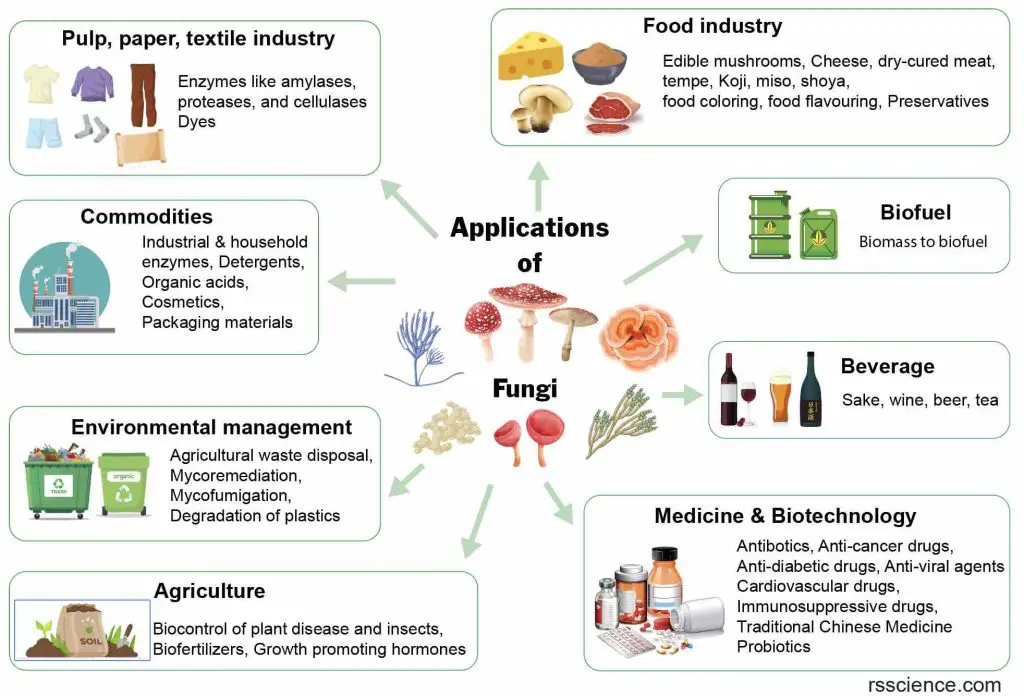
[In this image] Daily products produced by fungi.
The Classification of Molds – Zygomycota and Ascomycota
Types of molds
Mold is a general term for a diverse group of fungal species that grow on decomposed organic materials (i.e., food) in a fuzzy appearance. This appearance mainly comes from the spores produced on the surface of mold colonies.
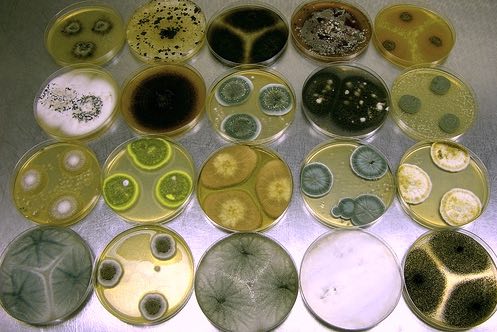
[In this image] Various Penicillium, Aspergillus spp., and other fungi growing in axenic culture.
Image source: wiki
Hyphomycetes is the scientific classification for molds, which are estimated to have 400,000 species. They can be classified into two divisions or phyla: Zygomycota and Ascomycota. The difference between these two divisions is mainly related to their sexual reproduction and spore production.
- Zygomycota (conjugated fungi) produce non-segmented hyphae with several nuclei. Their hyphae fuse during sexual reproduction to produce zygospores.
- Ascomycota (sac fungi) have hyphae that are divided by cell walls, and each cell contains a single nucleus. They form spores in sacs called asci during sexual reproduction.
Table. Comparison between Zygomycota and Ascomycota.
| Phylum (Group) | Zygomycota (Zygomycetes) | Ascomycota (Ascomycetes) |
| Other names | Conjugated fungi | Sac fungi |
| Hyphae | Non-septate cell wall, multi nuclei  | Septate cell wall, one nucleus per cell  |
| Asexual Reproduction | Non-motile spores formed in sporangia | Conidia formed on the tips of conidiophores |
| Sexual Reproduction | Zygospores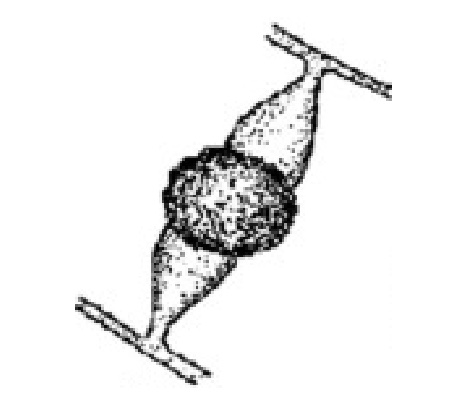 | Ascospores (inside sac-like asci)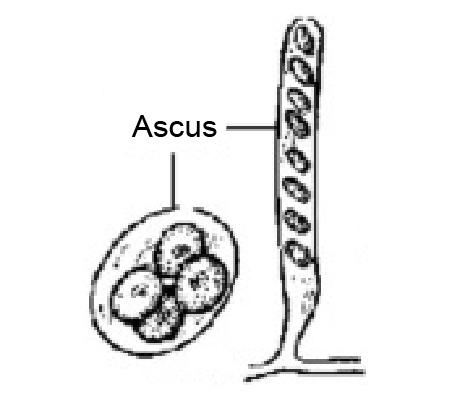 |
| Basic structures | 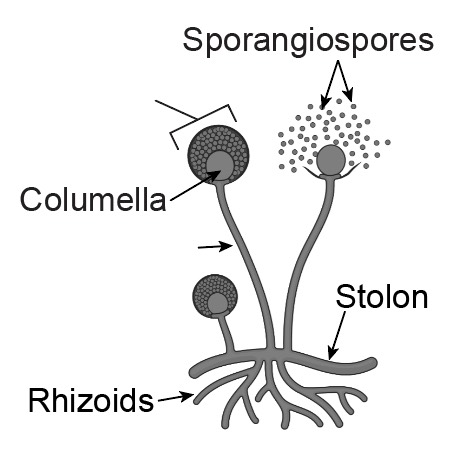 | 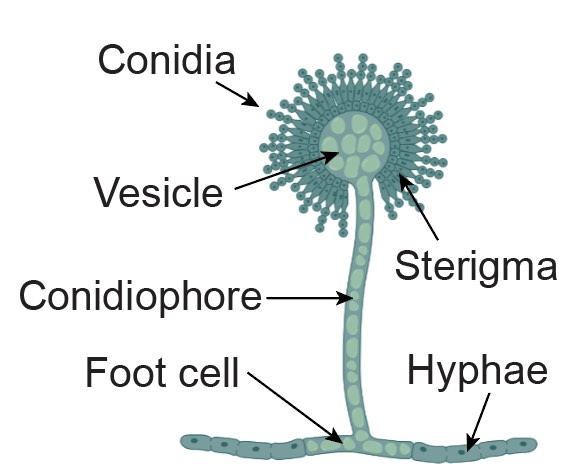 |
| Examples | Rhizopus stolonifera (black bread mold), Mucor species | Aspergillus fumigatus; Penicillium chrysogenum |
| Pictures | 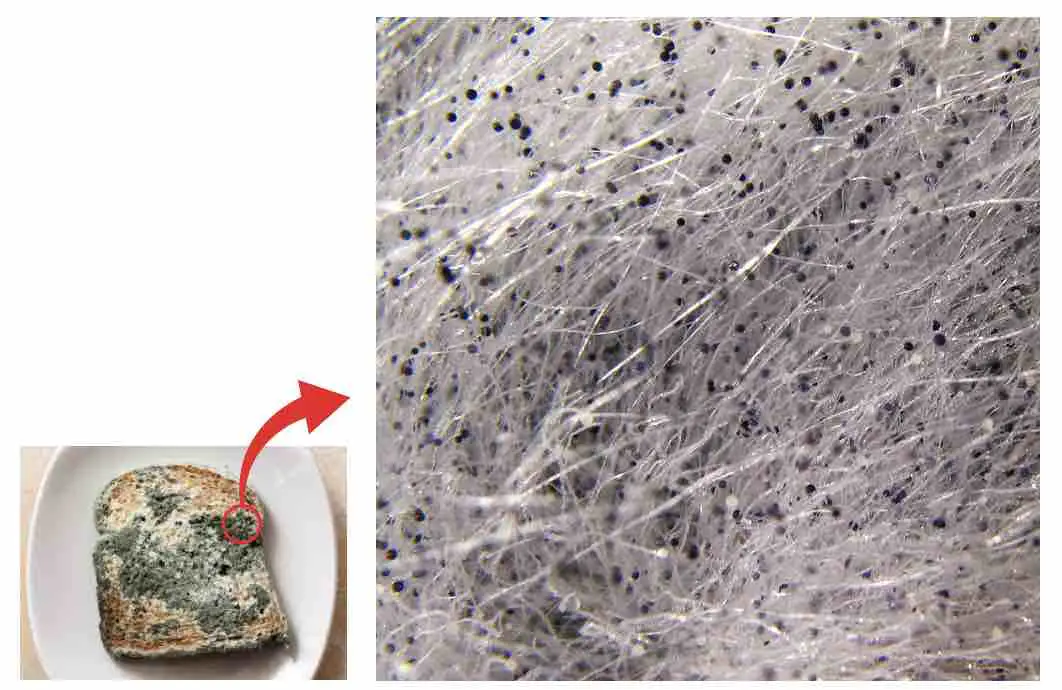 | 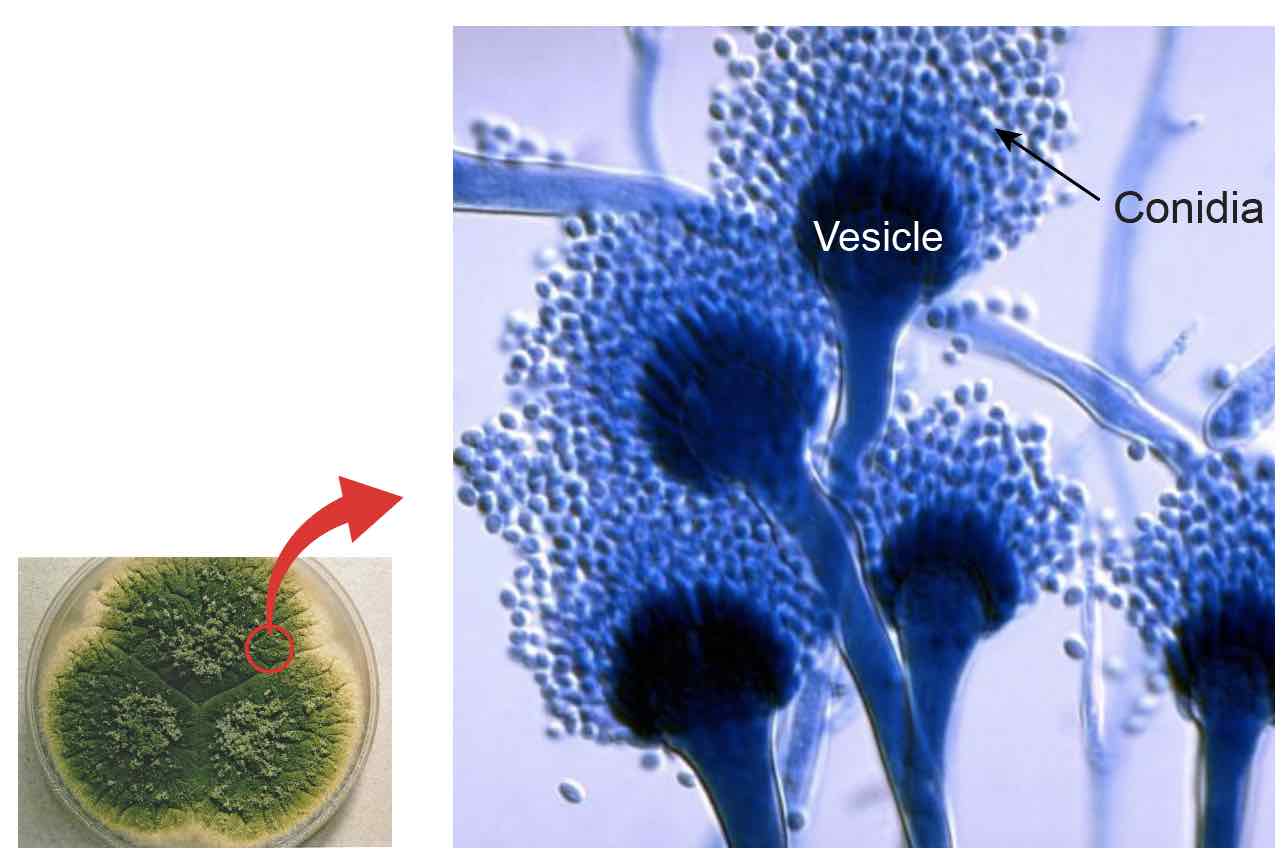 |
It is worth noting that the term “mold” has historically been used to describe organisms such as water molds or slime molds, which are no longer classified as fungi under the current taxonomy.
Examples of Common Molds – Rhizopus, Aspergillus, and Penicillium
Three common types of molds
There are three common types (or genus) of molds:
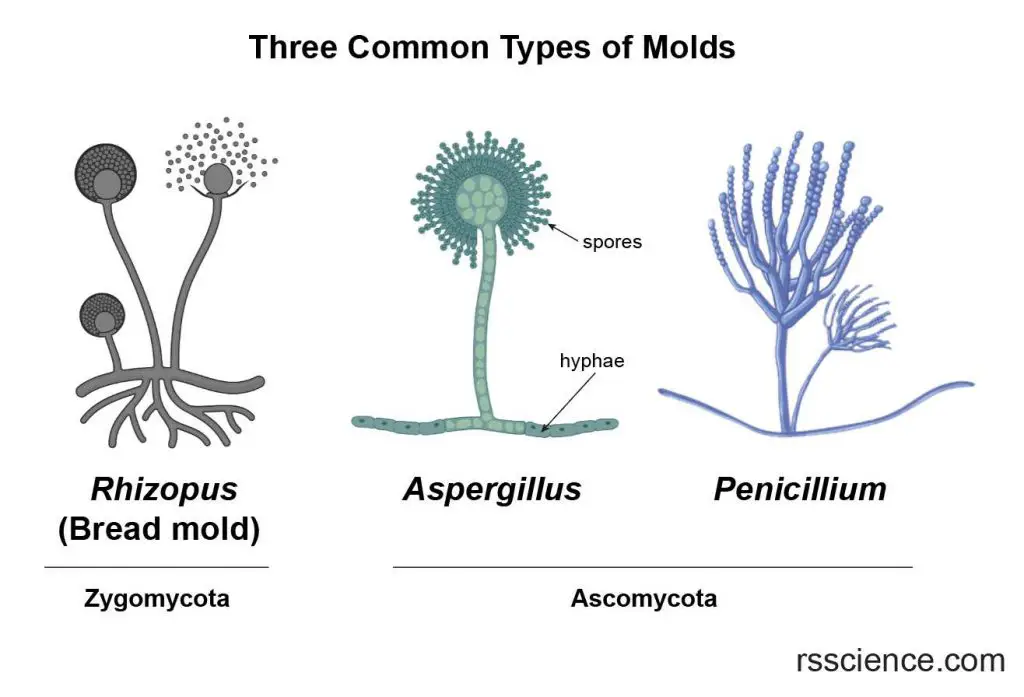
[In this image] Three common types of molds – Rhizopus, Aspergillus, and Penicillium.
Rhizopus
Rhizopus is classified under Zygomycota. This group comprises various species such as Rhizopus stolonifera, commonly known as black bread molds, that commonly decompose stored food. Rhizopus thrives rapidly in humid indoor environments, and certain species can cause a severe and often fatal illness known as mucormycosis in humans.
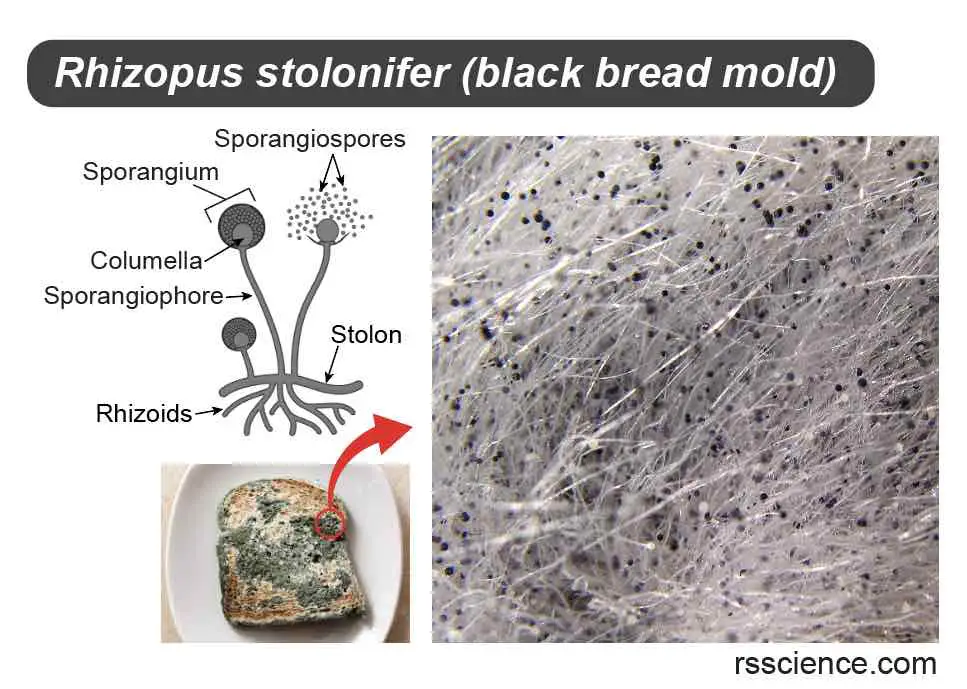
[In this image] Rhizopus stolonifera or black bread mold is the most common specie of Rhizopus.
Aspergillus
Aspergillus is a genus of molds within the Ascomycota classification, comprising several hundred species. Some Aspergillus species are used in industry as they produce enzymes such as lysozyme. However, certain species can cause infections in humans and animals.
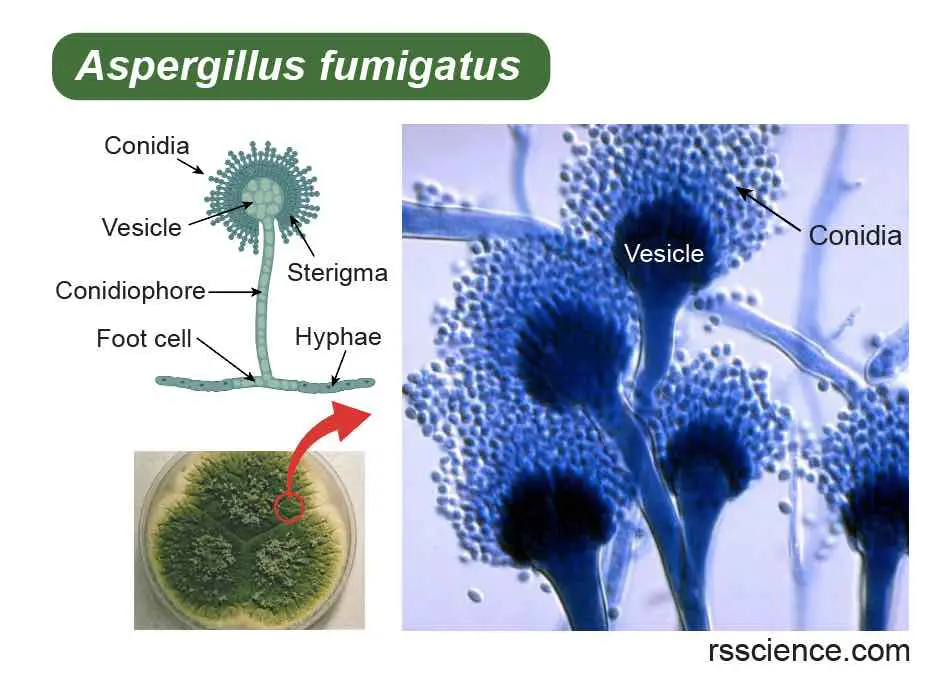
[In this image] Aspergillus fumigatus is an opportunistic pathogen that can cause diseases in humans.
Penicillium
Penicillium is a genus of Ascomycota fungi that is present in many environments and plays a significant role in food spoilage and in the production of food and drugs. The first antibiotic, penicillin, was discovered from a specie called Penicillium chrysogenum.
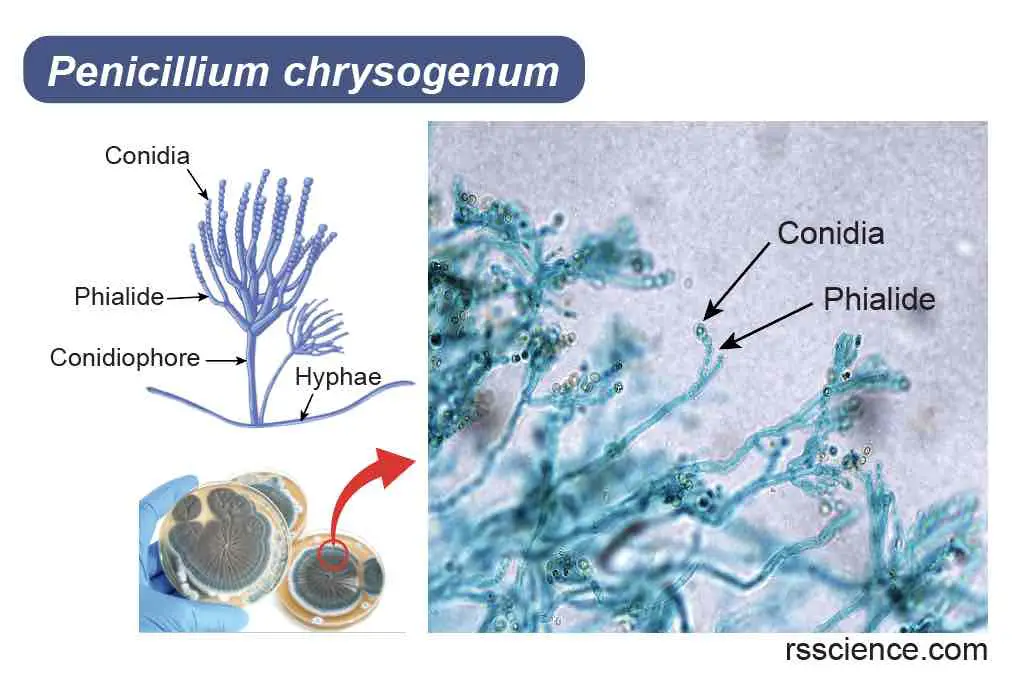
[In this image] Penicillium chrysogenum is the specie that produces penicillin.
The Anatomy of Molds – hyphae and spores
The structures of Penicillium
Here, we use Penicillium as an example of Ascomycota to show you the basic structures of molds.
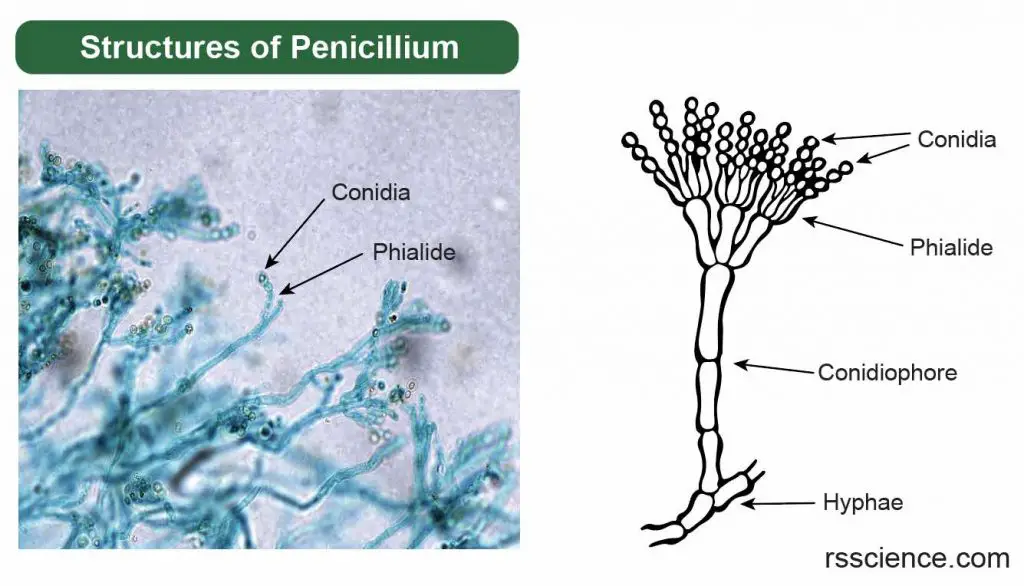
[In this image] The basic structures of Penicillium.
A network of hyphae
Most fungi grow as hyphae (from Ancient Greek, meaning “web”; singular hypha). Hyphae are long, thread-like, filamentous structures that typically range from 2-10 micrometers in diameter and can be several centimeters in length.
Hyphae are the main structural component of fungi (for both molds and mushrooms) and are collectively called mycelium. Hyphae grow rapidly through asexual reproduction, also known as vegetative growth, enabling fungi to expand their territory quickly.
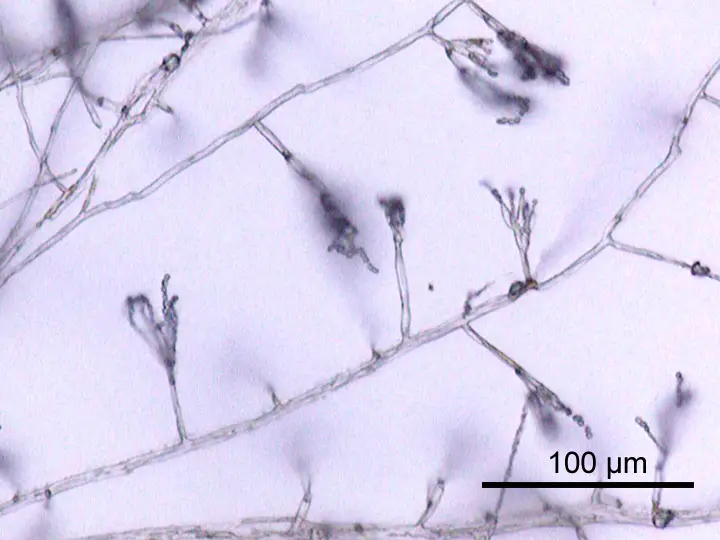
[In this image] Hyphae of Penicillium.
Image source: wiki
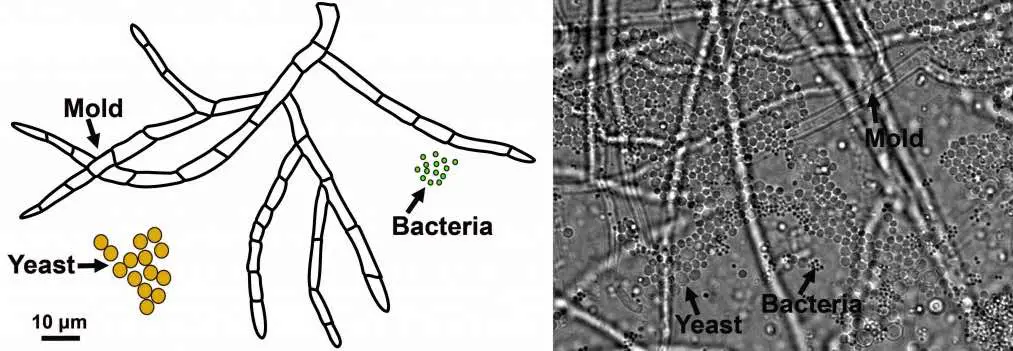
[In this image] A cartoon (left) and microscopic image (right) show the relative size comparison of molds, yeasts, and bacteria.
Image source: Microbialfoods.org
A hypha consists of one or more cells enclosed by a tubular cell wall. The major structural polymer in fungal cell walls is typically chitin, in contrast to plants that have cell walls made of cellulose.
Ascomycota fungi have hyphae that are divided by internal walls called “septa” (singular: septum), resulting in hyphae that are known as septate hyphae. Each compartment usually contains one nucleus. The septa contain pores that allow the flow of cytoplasm and small organelles between cells.
In contrast, fungi from the Zygomycota group have aseptate hyphae (or coenocytic hyphae), which means that their hyphae are not partitioned by septa.
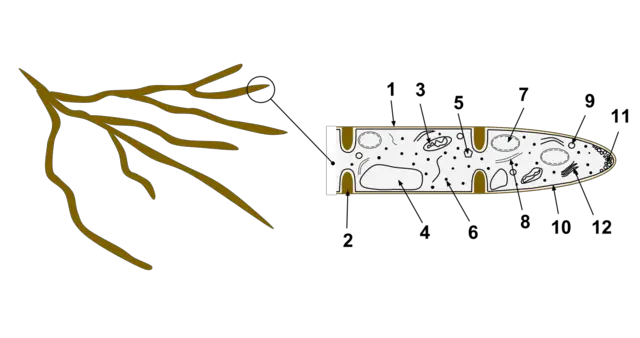
[In this image] Fungal hyphae cells: 1: Hyphal wall, 2: Septum, 3: Mitochondrion, 4: Vacuole, 5: Ergosterol crystal, 6: Ribosome, 7: Nucleus, 8: Endoplasmic reticulum, 9: Lipid body, 10: Plasma membrane, 11: Spitzenkörper, 12: Golgi apparatus.
Image source: wiki
Hyphae grow from their tips. During tip growth, cell walls are extended by the external assembly of cell wall components and the internal production of new cell membranes. The Spitzenkörper is an organelle found at the tip of hyphae, composed of an accumulation of membrane-bound vesicles that contain cell wall components.

[In this image] The detailed structure of Spitzenkörper.
image source: Riquelme M. and Sánchez-León E. Current Opinion in Microbiology, 2014
Hyphae can continue to grow and partition into individual cells through the formation of septa behind the growing tip. They also have the ability to branch off from established hyphae.
A network of hyphae can grow into decomposed organic materials such as bread, rotting fruits, or agar plates, absorbing nutrients in a similar way roots of a plant do. These structures are sometimes referred to as rhizoids.
Conidiophores – reproductive hyphae
Certain hyphae grow upwards and develop into specialized reproductive stalks called conidiophores. These conidiophores feature flask-shaped projections called phialides on the tip, which produce spores of fungi.
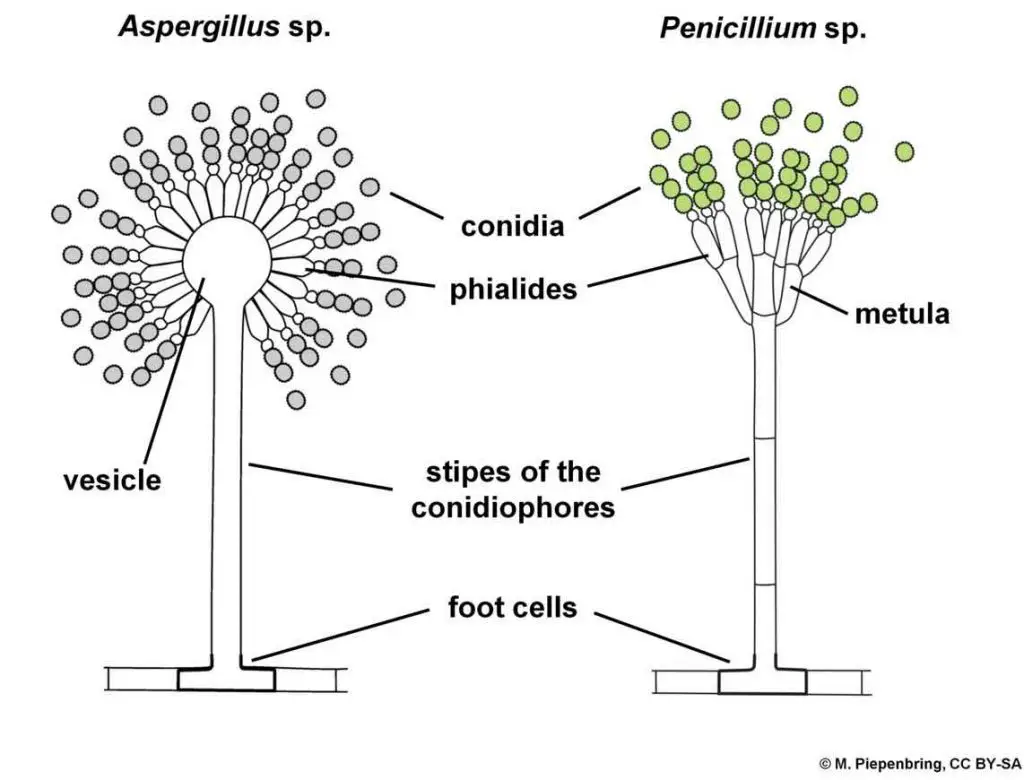
[In this image] Conidiophores of Aspergillus sp. and Penicillium sp.
Image source: Wikimedia commons
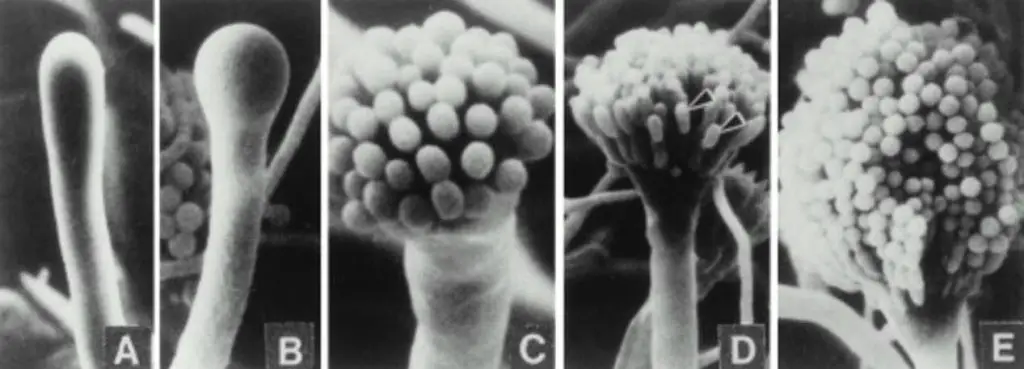
[In this image] Electron microscopic images showing the growth of conidiophores (from A to E).
Image source: Adams TH., et al., Microbiology and molecular biology reviews, 1998
Conidium
A conidium (plural: conidia) is an asexual, non-motile spore produced by fungi, also known as a chlamydospore or chlamydoconidium. The word “conidium” comes from the Ancient Greek word for “dust”. They are also referred to as mitospores, as they are produced through the cellular process of mitosis.
Conidia are produced at the tips of conidiophores through a process called conidiogenesis. Once mature, they can spread with the help of wind or animals. If they land in a suitable environment, they can grow into new hyphae and establish a new colony. The new fungi are genetically identical to their parent.

[In this image] Penicillium crystallinum. (A) Colonies. (B) Conidiophore. (C) Conidia.
Modified from Visagie CM., et.al., Studies in Mycology, 2014
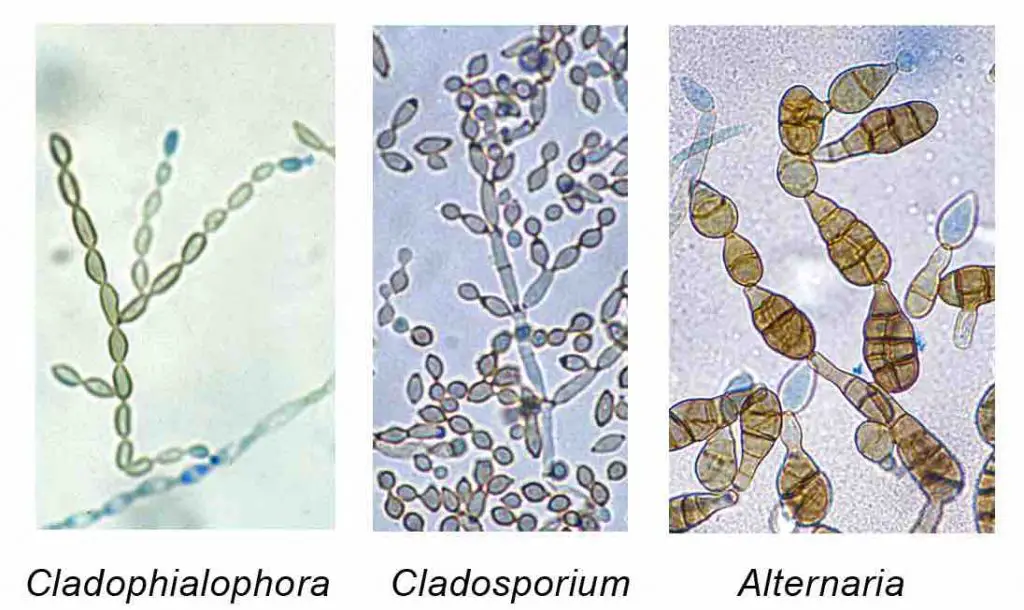
[In this image] The sizes, shapes, and arrangements of conidia are important characteristics in classifying the species of molds.
Image source: The University of Adelaide
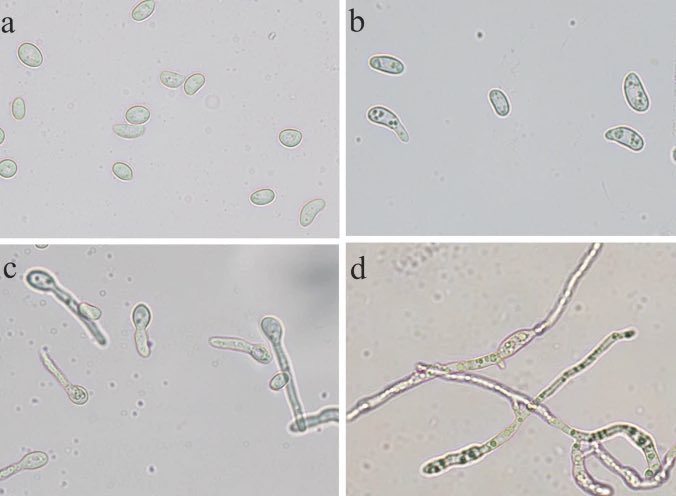
[In this image] If the condition is suitable, the conidia can rapidly grow into new hyphae through a process called germination. Here is an example of Fusarium oxysporum: (a) 0 h- resting conidia, (b) 2 h-initiation of hyphal swellings, (c) 6 h- emergence of the germ tube, (d) 24 h- hyphal elongation and branching.
Image source: Sharma M., et. al., Scientific reports, 2016
The structure of Aspergillus
Aspergillus and Penicillium are both Ascomycota fungi and share a similar structure with some minor differences. They both grow by filamentous hyphae, forming a mycelium. Some hyphae differentiate into L- or T-shaped foot cells, which branch to create conidiophores.
On the tips of the conidiophores of Aspergillus, hyphae give rise to spherical, elliptical, or club-shaped structures called vesicles. The surface of these vesicles is covered with a layer of phialide cells or sterigma, similar to the petals of a dandelion.
Conidia develop from the sterigma and are arranged in chains, with the youngest at the base and the oldest at the top.
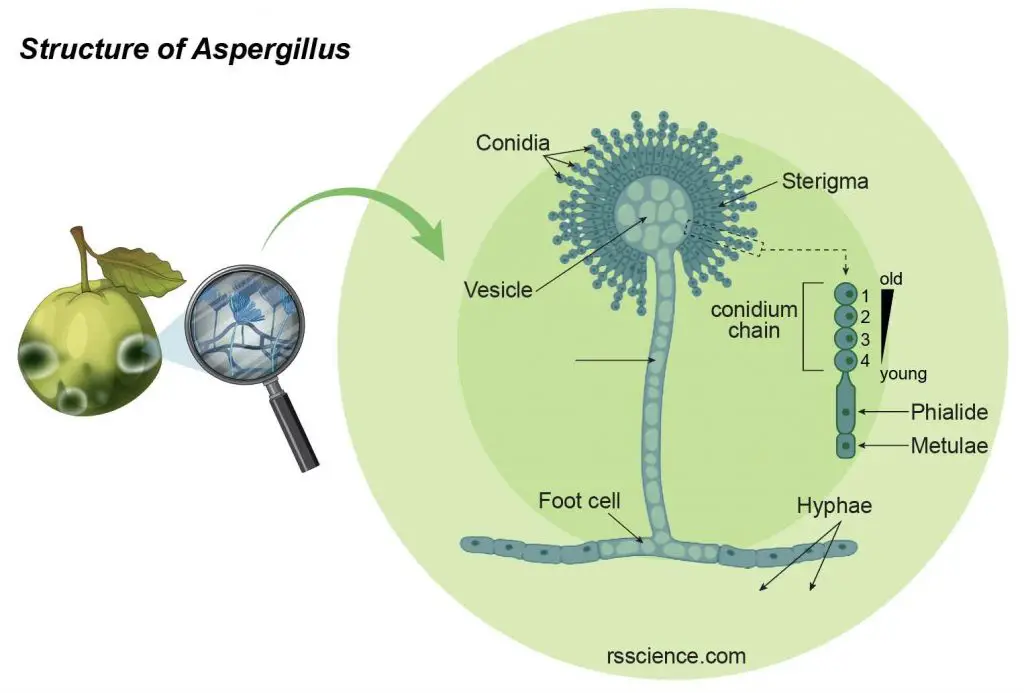
[In this image] The basic structures of Aspergillus.
The structure of Rhizopus
The structure of Rhizopus is distinct from that of Penicillium and Aspergillus as it belongs to the Zygomycota group.
Coenocytic hyphae
Rhizopus hyphae are typically coenocytic, meaning that they lack septa between cells, allowing for multiple nuclei in a single cell.
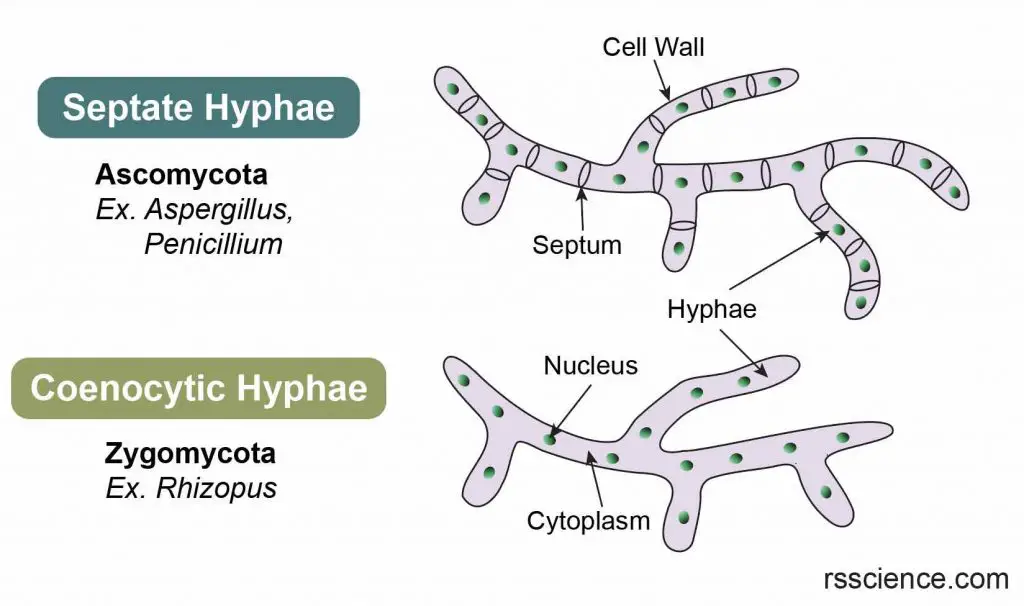
[In this image] Septate hyphae, found in Ascomycota fungi, are characterized by the presence of septa (cross walls) that divide the hyphae into individual cells, each containing one nucleus. Coenocytic hyphae, found in Zygomycota fungi, lack septa, and therefore, one cell can have multiple nuclei.
Sporangia and sporangiospores
Rhizopus reproduces asexually by forming non-motile spores called sporangiospores inside of sporangia (singular: sporangium). These sporangia are enclosures that form at the tips of sporangiophores. During asexual reproduction, the walls of the sporangia rupture, releasing the spores into the environment, where they can be dispersed by wind.
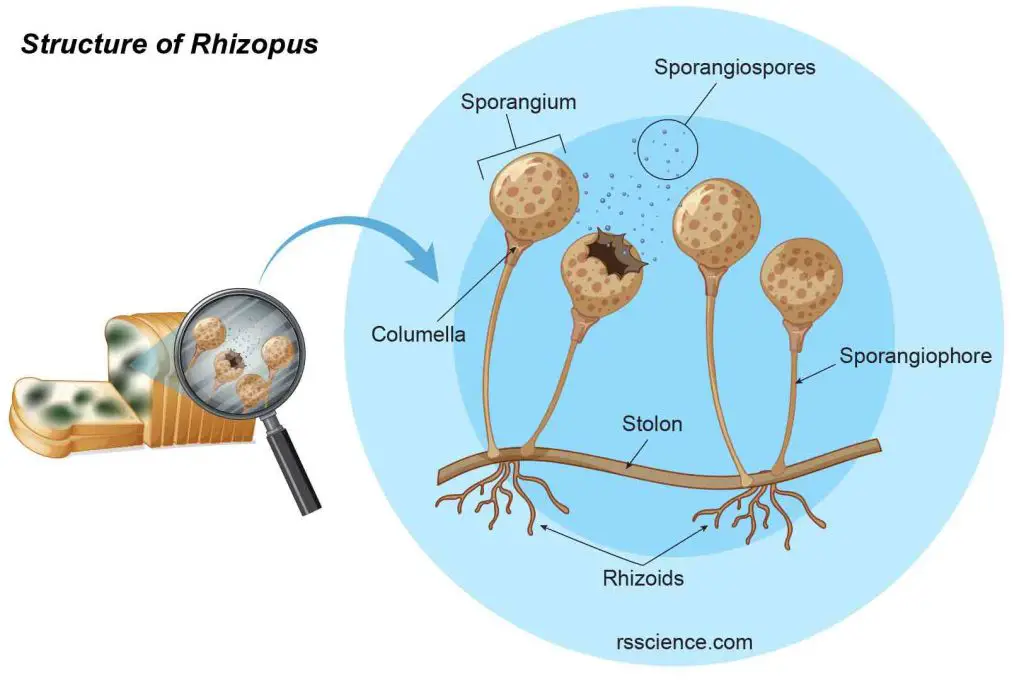
[In this image] The basic structures of Rhizopus.
How do Molds grow?
Molds like to grow on humid, dark organic matter
Molds thrive in moist, warm environments with a source of organic matter to feed on. They are commonly found in damp, humid areas such as bathrooms, basements, and kitchens. They also grow well in dark, enclosed spaces, such as inside walls or under carpeting.
Molds require humidity to survive, as their spores need water to initiate their life cycle. Once the spores settle, they begin to germinate and form hyphae. These hyphae then grow and branch out, forming a dense network called mycelium. The mycelium produces enzymes that break down organic matter and release nutrients that the molds can absorb. As the molds grow, they produce more spores that are released into the air and can start the growth process again.
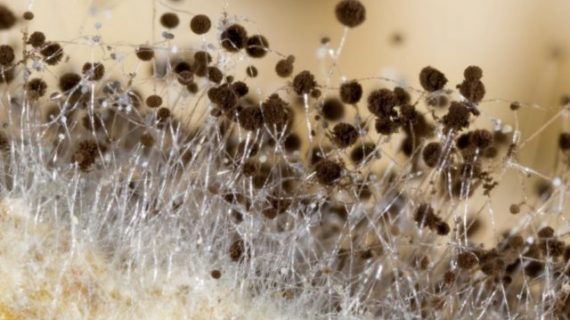
[In this image] The growth of black bread molds resemble that of a lawn. Their hyphae extend into the organic matter to obtain nutrients, while also producing spores to spread and colonize further.
Image source: Clean water partners
Mold can’t get nutrients from inorganic materials like concrete, glass, metal, or plastic. However, a buildup of dust layers containing carbon sources like human skin, pet dander, insect waste, and dirt on the surfaces of these materials can provide a source of nutrition for mold. As a result, mold can grow on these surfaces as well.
Life cycles of molds
Most molds follow the same four-stage life cycle: Hyphae growth, Spore formation, Spore liberation (dispersal), and Spore germination.
1. Hyphae growth
Hyphae are the cells that initiate the life-cycle process. They divide through mitosis and can rapidly grow to expand the territory of the molds. They release digestive enzymes that aid in breaking down the substrate for nutrition. As the hyphae consume the organic material, they form a large colony known as mycelium.
2. Asexual spore production
Once the mycelium is established, spores will form at the ends of certain hyphal cells. These spores are produced by mitosis and used for asexual reproduction. The formation of spores is highly dependent on environmental factors such as the availability of substrate, oxygen levels, ambient temperature, and light. If the ideal conditions for spore formation are not met, the life-cycle process will cease.
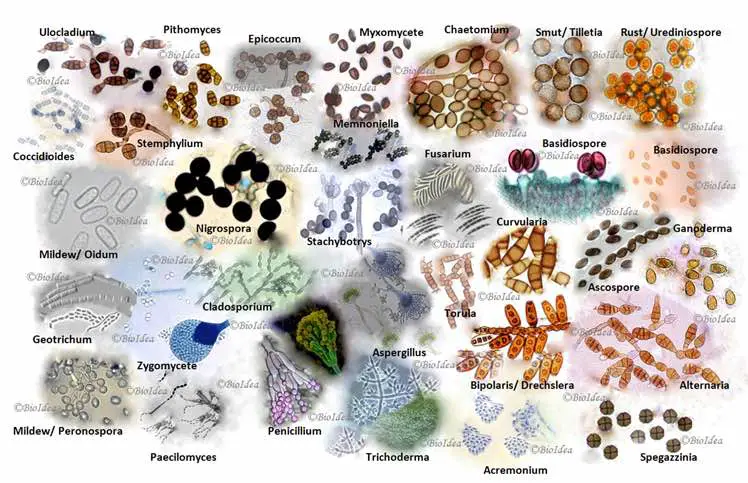
[In this image] Wild various morphology of molds and their spores.
Image source: Bioidea.net
3. Spore liberation
The spores are then released for dispersal, and as mentioned earlier, they can be transported through mediums like air and water or animals to begin the germination process again. Unlike other organisms, mold spores are incredibly durable and can remain dormant for years in dry environments.
4. Spore germination
When a mold spore lands on a damp surface that provides both nutrients and oxygen, it will begin to germinate and form a new hyphae cell. The life cycle then repeats itself indefinitely. Without ideal conditions for growth (moisture, nutrients, and oxygen) mold will not be able to grow.
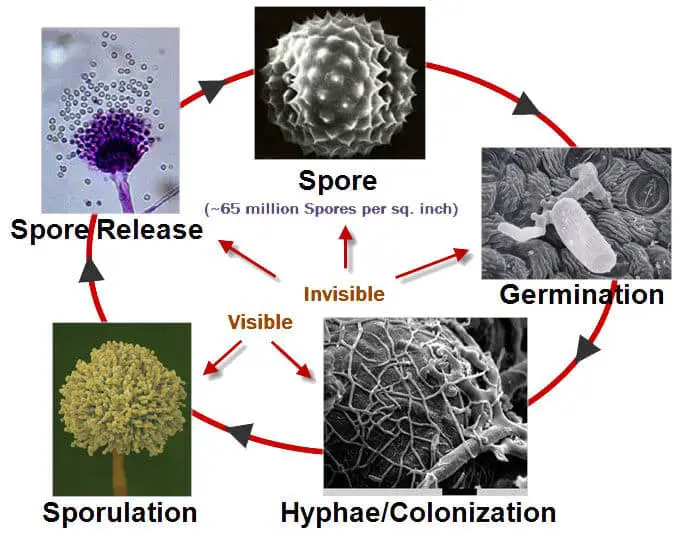
[In this image] Life cycle of molds and the representative microscopic images.
Image source: Emerg-NC
Sexual reproduction
Molds typically reproduce asexually; however, they may enter into a sexual reproduction cycle when environmental conditions become unfavorable.
Sexual reproduction in fungi involves the fusion of genetic material from two fungi and a rearrangement of genes through meiosis. This process increases genetic diversity, promoting the chances of survival under stressful conditions. The sexual reproduction cycles for Zygomycetes and Ascomycetes are distinct (see images below).
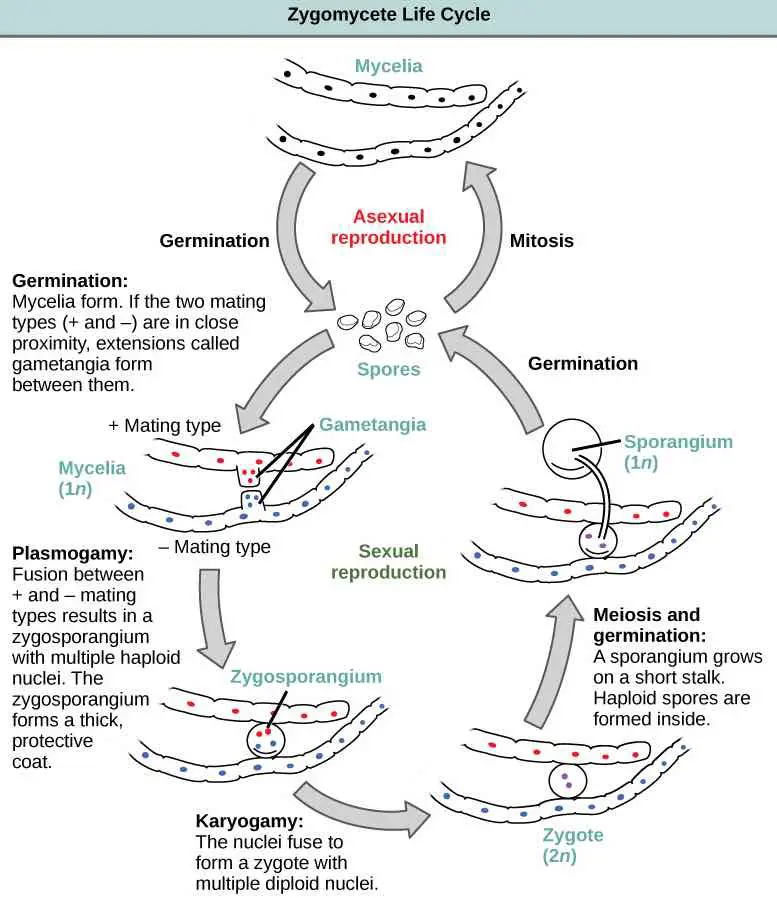
[In this image] Zygomycetes have asexual and asexual life cycles. In the sexual life cycle, plus and minus mating types conjugate to form a zygosporangium, which produces spores.
Image source: LibreTexts Biology
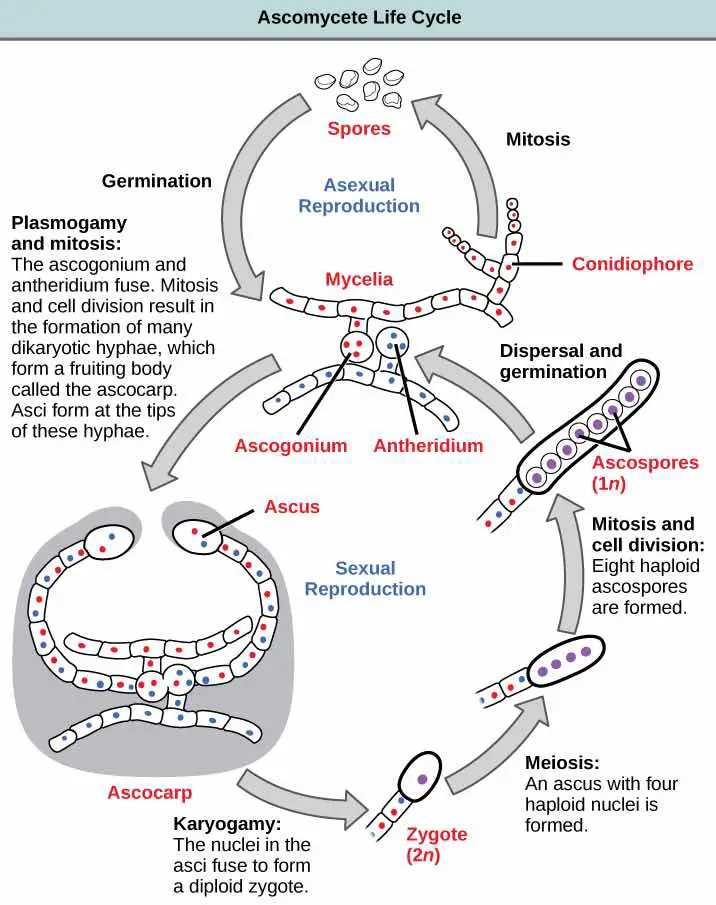
[In this image] In the sexual reproduction cycle of Ascomycetes, hyphae from two different mating types fuse to form asci (sac-like structures) and produce ascospores.
Image source: LibreTexts Biology
Good and Bad of Molds
Molds can cause diseases in humans, animals, and plants
Molds can cause illnesses in humans and animals. These health effects can result from an allergic reaction to mold, the growth of pathogenic molds within the body, or the ingestion or inhalation of mycotoxins produced by molds.
The danger of the mold will depend on what type it is. There are three main classifications of mold:
Hazard Class A – Toxic Molds: Some molds can produce toxic substances called mycotoxins and can lead to serious or even fatal health conditions. The poison caused by mycotoxins is known as Mycotoxicosis.
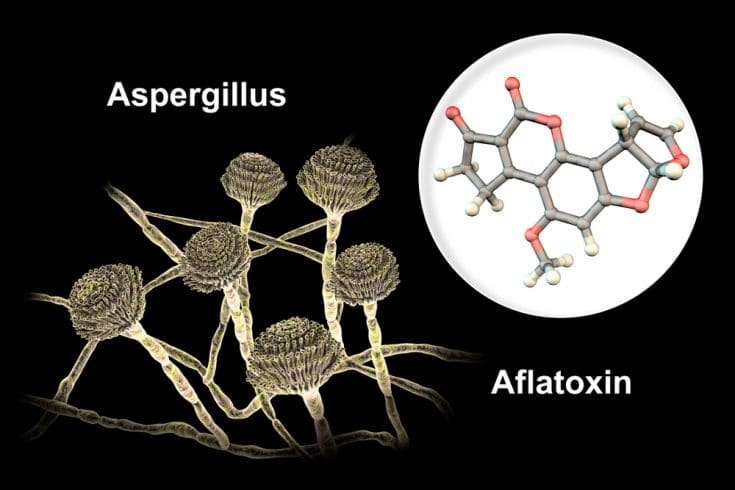
[In this image] Aflatoxin is an example of mycotoxin and one of the most potent carcinogens known to humans. Aflatoxins are produced by some species of Aspergillus and Penicillium.
Image source: Mold Help For You
Hazard Class B – Allergenic Molds: These molds can cause allergic reactions such as eye irritation, skin irritation, or asthma.
Hazard Class C – Pathogenic Molds: Many fungal infections (called Mycoses) are superficial, affecting only the skin, hair, and nails. However, some pathogenic molds can also enter the body through the respiratory system. These opportunistic pathogens are more likely to attack people with a weakened immune system, making infants and the elderly particularly vulnerable.
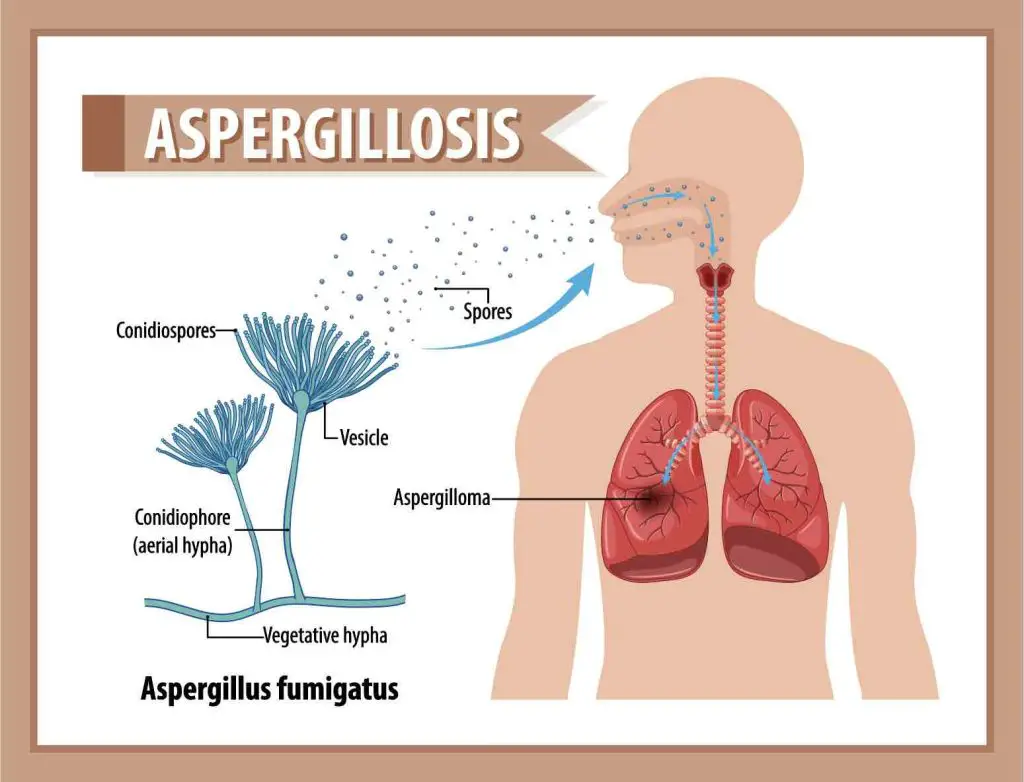
[In this image] Aspergillosis is an infection caused by Aspergillus, a common mold that lives indoors and outdoors. Most people breathe in Aspergillus spores every day without getting sick. However, people with weakened immune systems or lung diseases are at a higher risk of developing health problems due to Aspergillus.
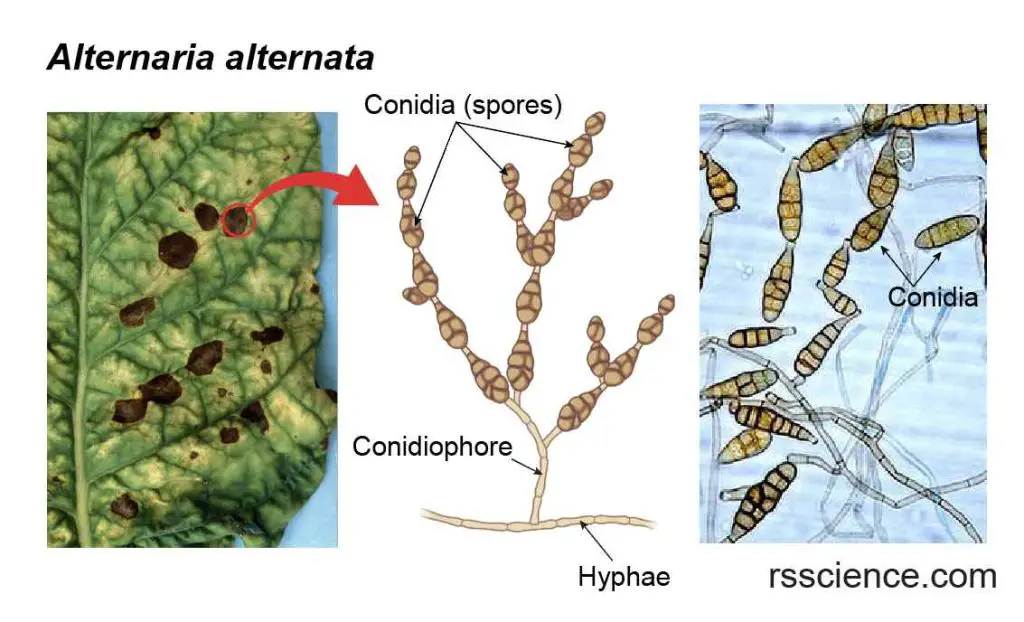
[In this image] Alternaria alternata is a fungus that causes leaf spots and other diseases on more than 380 different types of plants. It can also cause upper respiratory tract infections and asthma in people with compromised immunity. Its conidia can grow by branching from older conidia.
Image source: modified from wikipedia
Fungal infections can be difficult to treat because, unlike bacteria, fungi are eukaryotic organisms. Antibiotics only target prokaryotic cells, whereas compounds that are effective against fungi may also harm the eukaryotic host like humans.
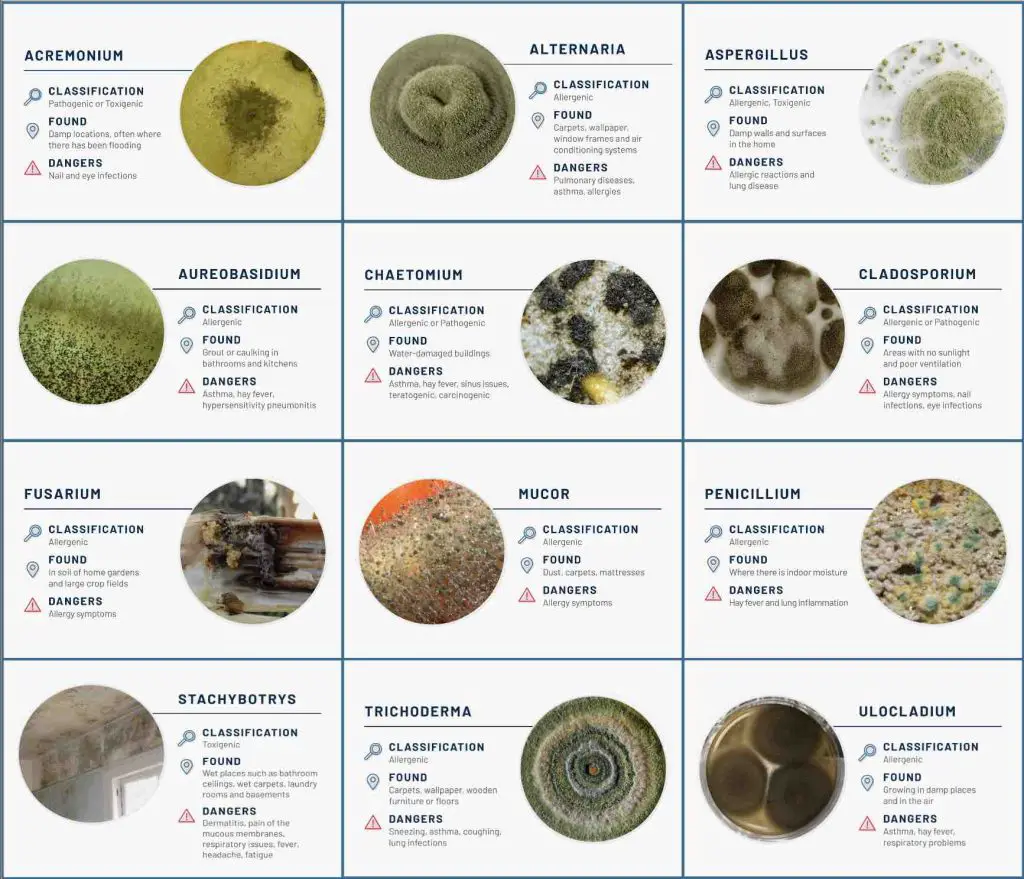
[In this image] 12 common types of molds found in the home and their associated health risk.
Image source: modified from Apartmentguide
Molds can cause diseases in plants as well. Some molds can infect leaves, stems, and roots, causing leaf spots, wilting, and stunted growth. They can also infect fruits and vegetables, causing rot and rendering them unmarketable.
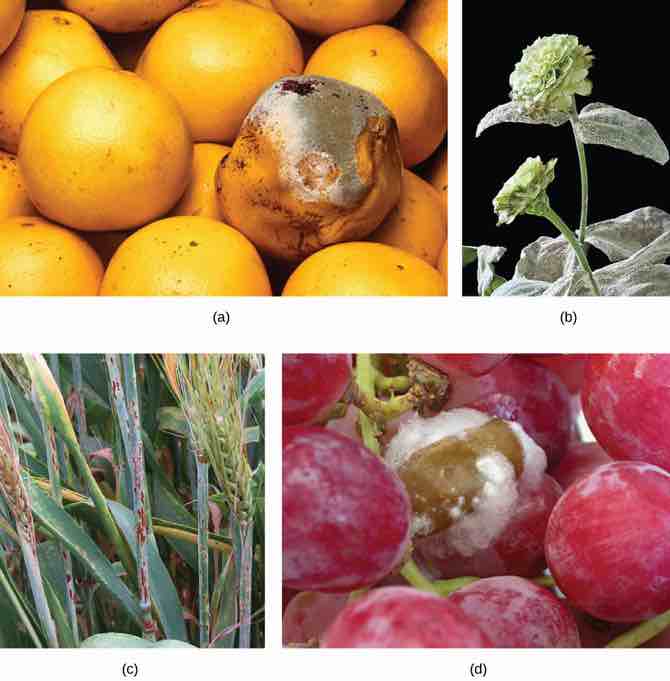
[In this image] Fungal pathogens of plants: (a) green mold on grapefruit, (b) powdery mildew on a zinnia, (c) stem rust on a sheaf of barley, and (d) grey rot on grapes.
Image source: LibreTexts
Molds can cure human diseases – The discovery of penicillin
Penicillin, the first antibiotic, was discovered through the study of a contaminated mold. This mold belongs to a genus of fungi known as Penicillium, which is commonly found in soil and on plants. Before the age of penicillin, we were almost helpless when facing a bacterial infection. The discovery of penicillin revolutionized the way bacterial infections are treated and has saved countless lives. Despite their small size, these microorganisms have had a significant impact on modern medicine.
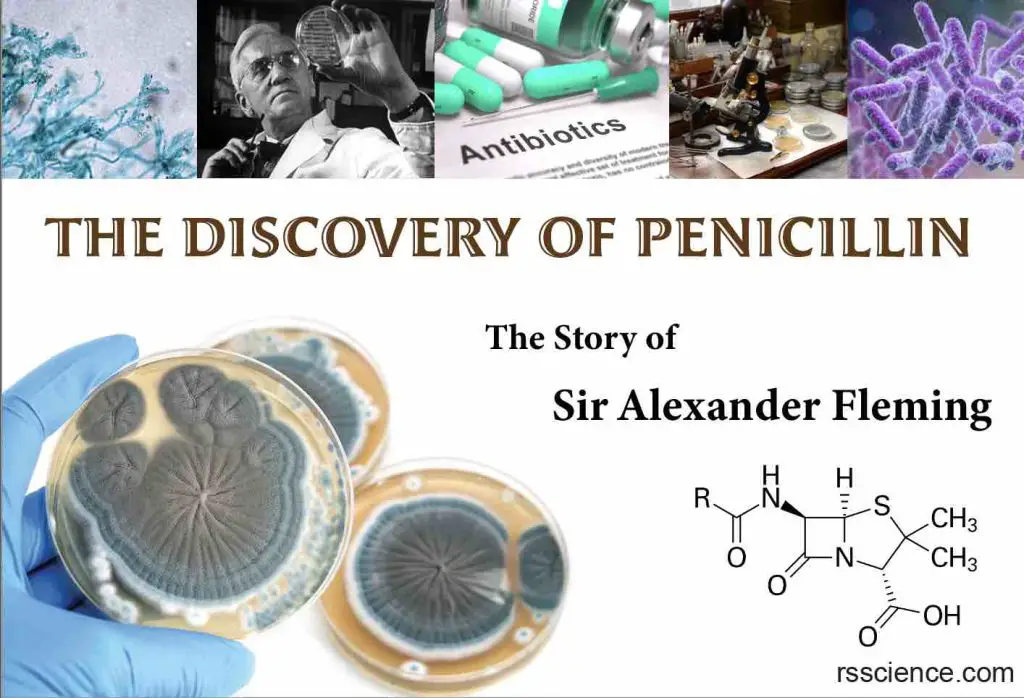
[In this image] The discovery of penicillin is credited to Alexander Fleming in 1928. He observed that a mold called Penicillium had contaminated one of his Petri dishes of Staphylococcus bacteria, and that the bacteria surrounding the mold had been killed. He identified the mold as the source of the bacteria-killing substance, which he named penicillin. Further research and development on penicillin were carried out by Howard Florey and Ernst Chain in the early 1940s, which led to the mass production and widespread use of the antibiotic. Read more about this story
Today, scientists have discovered and produced a variety of antibiotics from molds. In addition to anti-bacterial substances, several anti-viral and anti-cancer drugs have also been found in molds. These discoveries have led to new treatments for various diseases and have expanded the range of therapeutic options available to us.
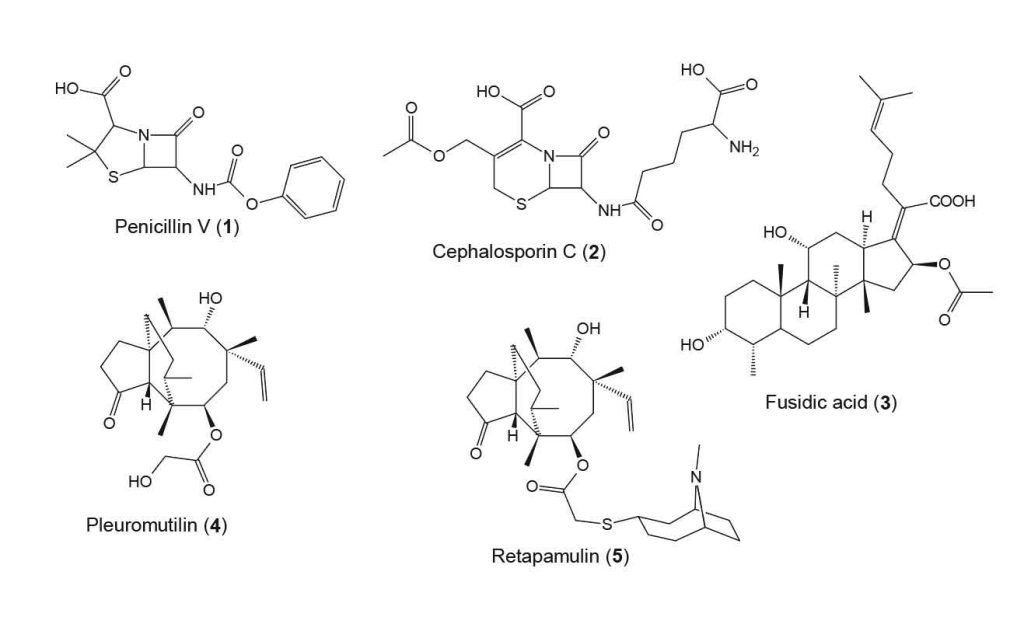
[In this image] Chemical structures of fungal metabolites that were developed for antibacterial drugs.
Molds are important microorganisms in industry and food production
Molds could be more beneficial than you think. Many species of molds have become very important industrial microorganisms in many different products.
Molds have a variety of industrial applications, some of which are:
- Food production: Molds are used in the production of certain foods such as cheese, soy sauce, salami, and fermented foods like tempeh and Miso.
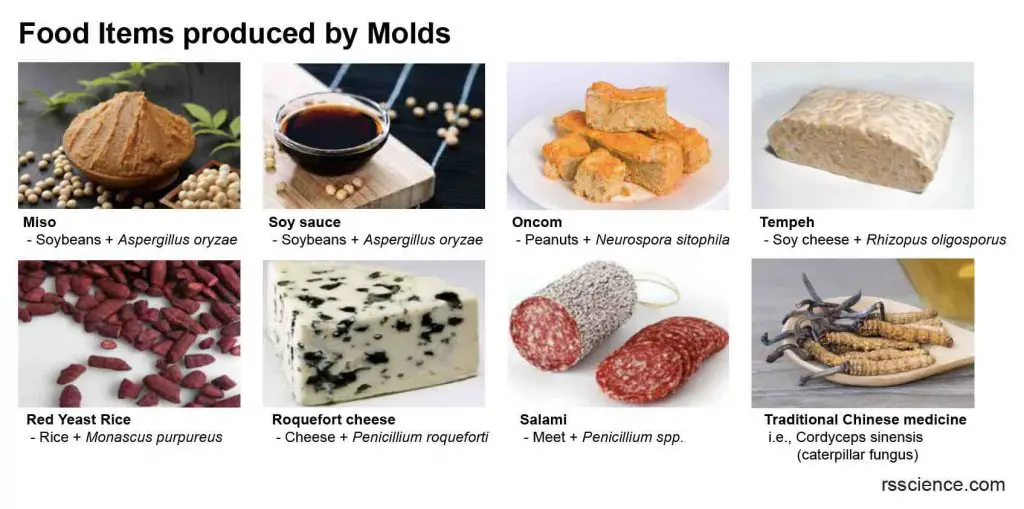
[In this image] Examples of food items produced by the aids of molds.
- Pharmaceuticals: Many antibiotics and anti-cancer drugs are produced by molds.
- Biotechnology: Molds are used in genetic engineering to produce enzymes, hormones, and other proteins.
- Agriculture: Molds are used in the production of animal feed, fertilizers, and pesticides.
- Industrial production: Molds are used in the production of industrial enzymes, organic acids, and other chemical products.
- Bioremediation: Molds are used to degrade and remove pollutants from the environment by breaking down toxic compounds.

[In this image] Daily products produced by fungi.
Summary
1. Mold is a type of fungus that grows in multicellular fiber-liked structures called hyphae and reproduces by spreading spores.
2. Fungi are eukaryotic cells but do not belong to animal or plant kingdoms. They have cell walls but do not carry out photosynthesis (so they are not plants).
3. Fungi are heterotrophic organisms that obtain food from other organisms but cannot move freely (this is why they are not animals). Fungi thrive in humid and dark environments and play a crucial role as decomposers in ecological systems. They all reproduce through spores which can travel via air, water, or animals.
4. Molds can be classified into two divisions or phyla: Zygomycota (Conjugated fungi) and Ascomycota (Sac fungi). Conjugated fungi hyphae doesn’t have a septate cell wall.
5. Three common types of molds are Rhizopus, Aspergillus, and Penicillium.
6. Most molds follow the same four-stage life cycle: Hyphae growth, spore formation, spore liberation (dispersal), and spore germination.
7. Molds typically reproduce asexually; however, they may enter into a sexual reproduction cycle when environmental conditions become unfavorable.
8. Penicillin, the first antibiotic, was discovered through the study of a contaminated mold. Penicillin revolutionized the way for bacterial infection treatment.
9. Molds have a variety of industrial applications, including food production, pharmaceuticals, animal feed, fertilizers, pesticides, biotechnology, and bioremediation.

